橡胶制品压缩永久变形测试
d395橡胶压缩永久变形特性试验方法
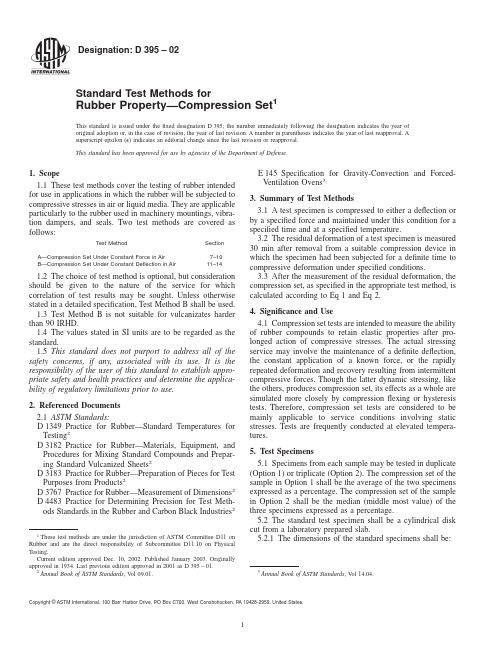
Designation:D395–02Standard Test Methods forRubber Property—Compression Set1This standard is issued under thefixed designation D395;the number immediately following the designation indicates the year of original adoption or,in the case of revision,the year of last revision.A number in parentheses indicates the year of last reapproval.A superscript epsilon(e)indicates an editorial change since the last revision or reapproval.This standard has been approved for use by agencies of the Department of Defense.1.Scope1.1These test methods cover the testing of rubber intended for use in applications in which the rubber will be subjected to compressive stresses in air or liquid media.They are applicable particularly to the rubber used in machinery mountings,vibra-tion dampers,and seals.Two test methods are covered as follows:Test Method Section A—Compression Set Under Constant Force in Air7–10B—Compression Set Under Constant Deflection in Air11–14 1.2The choice of test method is optional,but consideration should be given to the nature of the service for which correlation of test results may be sought.Unless otherwise stated in a detailed specification,Test Method B shall be used.1.3Test Method B is not suitable for vulcanizates harder than90IRHD.1.4The values stated in SI units are to be regarded as the standard.1.5This standard does not purport to address all of the safety concerns,if any,associated with its use.It is the responsibility of the user of this standard to establish appro-priate safety and health practices and determine the applica-bility of regulatory limitations prior to use.2.Referenced Documents2.1ASTM Standards:D1349Practice for Rubber—Standard Temperatures for Testing2D3182Practice for Rubber—Materials,Equipment,and Procedures for Mixing Standard Compounds and Prepar-ing Standard Vulcanized Sheets2D3183Practice for Rubber—Preparation of Pieces for Test Purposes from Products2D3767Practice for Rubber—Measurement of Dimensions2 D4483Practice for Determining Precision for Test Meth-ods Standards in the Rubber and Carbon Black Industries2E145Specification for Gravity-Convection and Forced-Ventilation Ovens33.Summary of Test Methods3.1A test specimen is compressed to either a deflection or by a specified force and maintained under this condition for a specified time and at a specified temperature.3.2The residual deformation of a test specimen is measured 30min after removal from a suitable compression device in which the specimen had been subjected for a definite time to compressive deformation under specified conditions.3.3After the measurement of the residual deformation,the compression set,as specified in the appropriate test method,is calculated according to Eq1and Eq2.4.Significance and Use4.1Compression set tests are intended to measure the ability of rubber compounds to retain elastic properties after pro-longed action of compressive stresses.The actual stressing service may involve the maintenance of a definite deflection, the constant application of a known force,or the rapidly repeated deformation and recovery resulting from intermittent compressive forces.Though the latter dynamic stressing,like the others,produces compression set,its effects as a whole are simulated more closely by compressionflexing or hysteresis tests.Therefore,compression set tests are considered to be mainly applicable to service conditions involving static stresses.Tests are frequently conducted at elevated tempera-tures.5.Test Specimens5.1Specimens from each sample may be tested in duplicate (Option1)or triplicate(Option2).The compression set of the sample in Option1shall be the average of the two specimens expressed as a percentage.The compression set of the sample in Option2shall be the median(middle most value)of the three specimens expressed as a percentage.5.2The standard test specimen shall be a cylindrical disk cut from a laboratory prepared slab.5.2.1The dimensions of the standard specimens shall be:1These test methods are under the jurisdiction of ASTM Committee D11onRubber and are the direct responsibility of Subcommittee D11.10on PhysicalTesting.Current edition approved Dec.10,2002.Published January2003.Originallyapproved st previous edition approved in2001as D395–01.2Annual Book of ASTM Standards,V ol09.01.3Annual Book of ASTM Standards,V ol14.04.1Copyright©ASTM International,100Barr Harbor Drive,PO Box C700,West Conshohocken,PA19428-2959,United States.Type1A2BThickness,mm(in.)12.560.5(0.4960.02)6.060.2 (0.2460.01)Diameter,mm(in.)29.060.5(1.1460.02)13.060.2 (0.5160.01)A Type1specimen is used in Test Methods A and B.B Type2specimen is used in Test Method B.5.2.2When cutting the standard specimen,the circular die having the required inside dimensions specified in5.2.1shall be rotated in a drill press or similar device and lubricated by means of a soap solution.A minimum distance of13mm(0.51 in.)shall be maintained between the cutting edge of the die and the edge of the slab.The cutting pressure shall be as light as possible to minimize cupping of the cut edges.The dies shall be maintained carefully so that the cutting edges are sharp and free of nicks.5.3An optional method of preparing the standard specimen may be the direct molding of a circular disk having the dimensions required for the test method used and specified in 5.2.1.N OTE1—It should be recognized that an equal time and temperature,if used for both the slab and molded specimen,will not produce an equivalent state of cure in the two types of specimen.A higher degree of cure will be obtained in the molded specimen.Adjustments,preferably in the time of cure,must be taken into consideration if comparisons between the specimens prepared by different methods are to be considered valid. N OTE2—It is suggested,for the purpose of uniformity and closer tolerances in the molded specimen,that the dimensions of the mold be specified and shrinkage compensated for therein.A two-plate mold with a cavity13.060.1mm(0.51060.004in.)in thickness and29.2060.05 mm(1.14860.002in.)in diameter,with overflow grooves,will provide Type1specimens for Test Method A and Test Method B.A similar mold but having a cavity of6.360.3mm(0.2560.012in.)in thickness and 13.260.1mm(0.5260.004in.)in diameter will provide Type2 specimens for Test Method B.5.4When the standard test specimen is to be replaced by a specimen taken from a vulcanized rubber part of greater thickness than the one indicated in5.2.1,the sample thickness shall be reducedfirst by cutting transversely with a sharp knife and then followed by buffing to the required thickness in accordance with Practice D3183.5.5An alternative method of preparing specimens is by plying up cylindrical disks cut from a standard sheet prepared in accordance with Practice D3182using the specimen sizes specified in5.2.1and cutting as described in5.2.2,or where a drill press is not available cutting the specimens with a single stroke from a cutting die.5.5.1The disks shall be plied,without cementing,to the thickness required.Such plies shall be smooth,flat,of uniform thickness,and shall not exceed seven in number for Type1 specimens and four in number for Type2specimens.5.5.2Care shall be taken during handling and placing of the plied test specimen in the testfixture by keeping the circular faces parallel and at right angles to the axis of the cylinder.5.5.3The results obtained on plied specimens may be different from those obtained using solid specimens and the results may be variable,particularly if air is trapped between disks.5.5.4The results obtained on the specimens prepared by one of the methods may be compared only to those prepared by the same method.5.6For routine or product specification testing,it is some-times more convenient to prepare specimens of a different size or shape,or both.When such specimens are used,the results should be compared only with those obtained from specimens of similar size and shape and not with those obtained with standard specimen.For such cases,the product specification should define the specimen as to the size and shape.If suitable specimens cannot be prepared from the product,the test method and allowable limits must be agreed upon between the producer and the purchaser.6.Conditioning6.1Store all vulcanized test specimens or product samples to be tested at least24h but not more than60days.When the date of vulcanization is not known,make tests within60days after delivery by the producer of the article represented by the specimen.6.2Allow buffed specimens to rest at least30min before specimens are cut for testing.6.3Condition all specimens before testing for a minimum of 3h at2362°C(73.463.6°F).Specimens whose compression set properties are affected by atmospheric moisture shall be conditioned for a minimum of24h in an atmosphere controlled to5065%relative humidity.7.Precision and Bias47.1These precision statements have been prepared in ac-cordance with Practice D4483.Please refer to Practice D4483 for terminology and other testing and statistical concepts.7.2Prepared test specimens of two rubbers for Test MethodsA andB were supplied tofive laboratories.These were tested in duplicate each day on two separate testing days.A test result, therefore,is the average of two test specimens,for both Test Methods A and B.7.3One laboratory did not run the Test Method A testing; therefore,the precision for Test Method A is derived from four laboratories.7.4The Type1precision results are given in Table1and Table2.4Supporting data are available from ASTM Headquarters.Request RR: D11–1138.TABLE1Type1Precision Results,%Compression Set—TestMethod AMaterialMeanLevelWithin Laboratory A Between Laboratory AS r r(r)S R R(R)1 1.73(%)0.0500.1428.20.1900.5431.1 226.10.898 2.549.7 2.37 6.7125.7A Sr=within laboratory standard deviation.r=repeatability(in measurement units).(r)=repeatability(in percent).S R=between laboratory standard deviation. R=reproducibility(in measurement units). (R)=reproducibility(in percent).7.5Bias—In test method statistical terminology,bias is the difference between an average test value and the reference or true test property value.Reference values do not exist for these test methods since the value or level of the test property is exclusively defined by the test method.Bias,therefore,cannot be determined.TEST METHOD A—COMPRESSION SET UNDERCONSTANT FORCE IN AIR8.Apparatus8.1Dial Micrometer—A dial micrometer,for measuring specimen thickness,in accordance with Practice3767,Method A1.8.2Compression Device,consisting of a force application spring and two parallel compression plates assembled bymeans of a frame or threaded bolt in such a manner that the device shall be portable and self-contained after the force has been applied and that the parallelism of the plates shall be maintained.The force may be applied in accordance with either 8.2.1or8.2.2.8.2.1Calibrated Spring Force Application—The required force shall be applied by a screw mechanism for compressing a calibrated spring the proper amount.The spring shall be of properly heat-treated spring steel with ends ground and per-pendicular to the longitudinal axis of the spring.A suitable compression device is shown in Fig. 1.The spring shall conform to the following requirements:8.2.1.1The spring shall be calibrated at room temperature 2365°C(73.469°F)by applying successive increments of force not exceeding250N(50lbf)and measuring the corresponding deflection to the nearest0.2mm(0.01in.).The curve obtained by plotting the forces against the corresponding deflections shall have a slope of7063.5kN/m(400620 lbf/in.)at1.8kN(400lbf).The slope is obtained by dividing the two forces above and below1.8kN by the difference between the corresponding deflections.8.2.1.2The original dimensions of the spring shall not change due to fatigue by more than0.3mm(0.01in.)after it has been mounted in the compression device,compressed under a force of1.8kN(400lbf),and heated in the oven for one week at70°C62°C(15863.6°F).In ordinary use,a weekly check of the dimensions shall show no greater change than this over a period of1year.8.2.1.3The minimum force required to close the spring (solid)shall be2.4kN(530lbf).8.2.2External Force Application—The required force shall be applied to the compression plates and spring by external means after the test specimen is mounted in the apparatus. Either a calibrated compression machine or known masses may be used for force application.Provision shall be made by the use of bolts and nuts or other devices to prevent the specimen and spring from losing their initial deflections when the external force is removed.The spring shall have essentially the same characteristics as described in8.2.1,but calibration is not required.A suitable compression device is shown in Fig.2.8.3Plates—The plates between which the test specimen is compressed shall be made of steel of sufficient thickness to withstand the compressive stresses without bending.8.3.1The surfaces against which the specimen is held shall have a chromium platedfinish and shall be cleaned thoroughly and wiped dry before each test.8.3.2The steel surfaces contacting the rubber specimens shall be ground to a maximum roughness of250µm(10µin.) and then chromium plated and polished.8.3.3The chromium plating and subsequent polishing shall not affect thefinalfinish beyond the tolerance stated in8.3.2.8.4Oven,conforming to the specification for a Type IIB laboratory oven given in Specification E145.8.4.1Type IIB ovens specified in Test Method E145are satisfactory for use through70°C.For higher Temperatures Type II A ovens are necessary.8.4.2The interior size shall be as follows or of an equivalent volume:TABLE2Type1Precision Results,%Compression Set—TestMethod BMaterial MeanLevelWithin Laboratory A Between Laboratory AS r r(r)S R R(R)113.7(%)0.591 1.6712.2 1.54 4.3631.8 252.80.567 1.60 3.0 5.9216.831.7 A Sr=within laboratory standard deviation.r=repeatability(in measurement units).(r)=repeatability(in percent).S R=between laboratory standard deviation.R=reproducibility(in measurement units).(R)=reproducibility(in percent).Interior size of air oven:min.300bt300mm by300mm(12by12by12in.)max.900by900by1200mm(36by36by48in.) 8.4.3Provision shall be made for placing test specimens in the oven without touching each other or the sides of the aging chamber.8.4.4The heating medium for the aging chamber shall be air circulated within it at atmospheric pressure.8.4.5The source of heat is optional but shall be located in the air supply outside of the aging chamber.8.4.6A suitable temperature measurement device located in the upper central portion of the chamber near the test speci-mens shall be provided to record the actual aging temperature.8.4.7Automatic temperature control by means of thermo-static regulation shall be used.8.4.8The following special precautions shall be taken in order that accurate,uniform heating is obtained in all parts of the aging chamber.8.4.8.1The heated air shall be thoroughly circulated in the oven by means of mechanical agitation.When a motor driven fan is used,the air must not come in contact with the fan motor brush discharge because of danger of ozone formation.8.4.8.2Baffles shall be used as required to prevent local overheating and dead spots.8.4.8.3The thermostatic control device shall be so located as to give accurate temperature control of the heating medium. The preferred location is adjacent to the temperature measuring device listed in section8.4.6.8.4.8.4An actual check shall be made by means of maxi-mum reading thermometers placed in various parts of the oven to verify the uniformity of the heating.9.Procedure9.1Original Thickness Measurement—Measure the original thickness of the specimen to the nearest0.02mm(0.001in.). Place the specimen on the anvil of the dial micrometer so that the presser foot will indicate the thickness at the central portion of the top and bottom faces.9.2Application of Compressive Force—Assemble the specimens in the compression device,using extreme care to place them exactly in the center between the plates to avoid tilting.If the calibrated spring device(see Fig.1)is used,apply the compressive force by tightening the screw until the deflection as read from the scale is equivalent to that shown on the calibration curve for the spring corresponding to a force of 1.8kN(400lbf).With the external loading device(see Fig.2), apply this force to the assembly in the compression machine or by adding required masses,but in the latter case,take care to add the mass gradually without shock.Tighten the nuts and bolts just sufficiently to hold the initial deflections of the specimen and spring.It is imperative that no additional force be applied in tightening the bolts.9.3Test Time and Test Temperature—Choose a suitable temperature and time for the compression set,depending upon the conditions of the expected service.In comparative tests,use identical temperature and heating periods.It is suggested that the test temperature be chosen from those listed in Practice D1349.Suggested test periods are22h and70h.The specimen shall be at room temperature when inserted in the compression device.Place the assembled compression device in the oven within2h after completion of the assembly and allow it to remain there for the required test period in dry air at the test temperature selected.At the end of the test period,take the device from the oven and remove the specimens immedi-ately and allow it to cool.9.4Cooling Period—While cooling,allow the specimens to rest on a poor thermally conducting surface,such as wood,for 30min before making the measurement of thefinal thickness. Conduct the cooling period at a standard laboratory tempera-ture of2362°C(73.463.6°F).Specimens whose compres-sion set property is affected by atmospheric moisture shall be cooled in an atmosphere controlled to5065%relative humidity.9.5Final Thickness Measurement—After the rest period, measure thefinal thickness at the center of the specimen in accordance with9.1.10.Calculation10.1Calculate the compression set as a percentage of the original thickness as follows:C A5@~t o2t i!/t o#3100(1) where:C A=Compression set(Test Method A)as a percentage ofthe original thickness,t o=original thickness(see9.1),andt i=final thickness (see 9.5).11.Report11.1Report the following information:11.1.1Original dimensions of the test specimen,including the original thickness,t o ,11.1.2Actual compressive force on the specimen as deter-mined from the calibration curve of the spring and spring deflection reading (see 8.2.1)or as applied by an external force (see 8.2.2),11.1.3Thickness of the test specimen 30min after removal from the clamp,t i ,11.1.4Type of test specimen used,together with the time and temperature of test,11.1.5Compression set,expressed as a percentage of the original thickness,11.1.6Test method used (Test Method A),and 11.1.7Number of specimens tested.TEST METHOD B—COMPRESSION SET UNDERCONSTANT DEFLECTION IN AIR 12.Apparatus12.1Dial Micrometer —A dial micrometer,for measuring the specimen thickness,in accordance with Practice D 3767,Method A 1.N OTE 3—For vulcanizates having a hardness below 35IRHD,the force on the presser foot should be reduced to 0.260.05N (0.0460.01lbf).12.2Spacer Bars ,to maintain the constant deflection re-quired under Test Method B.12.2.1Spacer bars for Type 1samples shall have a thickness of 9.560.02mm (0.37560.001in.).12.2.2Spacer bars for Type 2samples shall have a thickness of 4.5060.01mm (0.177060.0005in.).12.3Compression Device ,consisting of two or more flat steel plates between the parallel faces of which the specimens may be compressed as shown in Fig.3.Steel spacers for the required percentage of compression given in 13.2shall be placed on each side of the rubber specimens to control their thickness while compressed.12.4Oven ,see 8.4.12.5Plates —The plates between which the test specimen is compressed shall be made of steel of sufficient thickness to withstand the compressive stresses without bending.12.5.1The surfaces against which the specimen is held shall have a chromium-plated finish and shall be cleaned thoroughly and wiped dry before each test.12.5.2The steel surfaces contacting the rubber specimens shall be ground to a maximum roughness of 250µm (10µin.)and then chromium plated and polished.12.5.3The chromium plating and subsequent polishing shall not affect the final finish beyond the tolerance stated in 12.5.2.13.Procedure13.1Original Thickness Measurement —Measure the origi-nal thickness of the specimen to the nearest 0.02mm (0.001in.).Place the specimen on the anvil of the dial micrometer so that the presser foot will indicate the thickness at the central portion of the top and bottom faces.13.2Application of Compressive Force —Place the test specimen between the plates of the compression device with the spacers on each side,allowing sufficient clearance for the bulging of the rubber when compressed (see Fig.3).Where a lubricant is applied,it shall consist of a thin coating of a lubricant having substantially no action on the rubber.For most purposes,a silicon or fluorosilicon fluid is suitable.Tighten the bolts so that the plates are drawn together uniformly until they are in contact with the spacers.The amount of compression employed shall be approximately 25%.A suitable mechanical or hydraulic device may be used to facilitate assembling and disassembling the test fixture.13.3Test Time and Temperature —Choose a suitable tem-perature and time for the compression set,depending upon the conditions of the expected service.In comparative tests,use identical temperature and test periods.It is suggested that the test temperature be chosen from those listed in Practice D 1349.Suggested test periods are 22h and 70h.The test specimen shall be at room temperature when inserted in the compression device.Place the assembled compression device in the oven within 2h after completion of the assembly and allow it to remain there for the required test period in dry air at the test temperature selected.At the end of the test period,take the device from the oven and remove the test specimen immediately and allow them to cool.13.4Cooling Period —While cooling,allow the test speci-men to rest on a poor thermally conducting surface,such as wood,for 30min before making the measurement of the final thickness.Maintain the conditions during the cooling period in accordance with 9.4.13.5Final Thickness Measurement —After the rest period,measure the final thickness at the center of the test specimen in accordance with 13.1.14.Calculation14.1Calculate the compression set expressed as a percent-age of the original deflection as follows:C B 5@~t o 2t i !/~t o 2t n !#3100(2)where:C B =compression set (Test Method B)expressed aspercentage of the original deflection,t 0=original thickness of specimen (13.1),t i =final thickness of specimen (13.5),and t n =thickness of the spacer bar used.N OTE 4—Lubrication of the operating surfaces of thecompressionFIG.3Device for Compression Set Test Under ConstantDeflection,Test MethodBdevice is optional while giving more reproducible results;lubrication may somewhat alter the compression set values.15.Report15.1Report the following information:15.1.1Original dimensions of the test specimen including the original thickness,t o,15.1.2Percentage compression of the specimen actually employed,15.1.3Thickness of the test specimen30min after removal from the clamp,t i,15.1.4Type of test specimen used,together with the time and temperature of test,15.1.5Whether or not the surfaces of the compression device are lubricated.If they are,what type lubrication was used,15.1.6Compression set,expressed as a percentage of the original deflection,15.1.7Test method used(Test Method B),and15.1.8Number of specimens tested.16.Keywords16.1compression set;compression set under constant de-flection;compression set under constant force;deflection; deformation;elastic property;hysteresis;recoveryASTM International takes no position respecting the validity of any patent rights asserted in connection with any item mentioned in this ers of this standard are expressly advised that determination of the validity of any such patent rights,and the risk of infringement of such rights,are entirely their own responsibility.This standard is subject to revision at any time by the responsible technical committee and must be reviewed everyfive years and if not revised,either reapproved or withdrawn.Your comments are invited either for revision of this standard or for additional standards and should be addressed to ASTM International Headquarters.Your comments will receive careful consideration at a meeting of the responsible technical committee,which you may attend.If you feel that your comments have not received a fair hearing you should make your views known to the ASTM Committee on Standards,at the address shown below.This standard is copyrighted by ASTM International,100Barr Harbor Drive,PO Box C700,West Conshohocken,PA19428-2959, United States.Individual reprints(single or multiple copies)of this standard may be obtained by contacting ASTM at the above address or at610-832-9585(phone),610-832-9555(fax),or service@(e-mail);or through the ASTM website().。
橡胶密封性能分析——测试方法比较
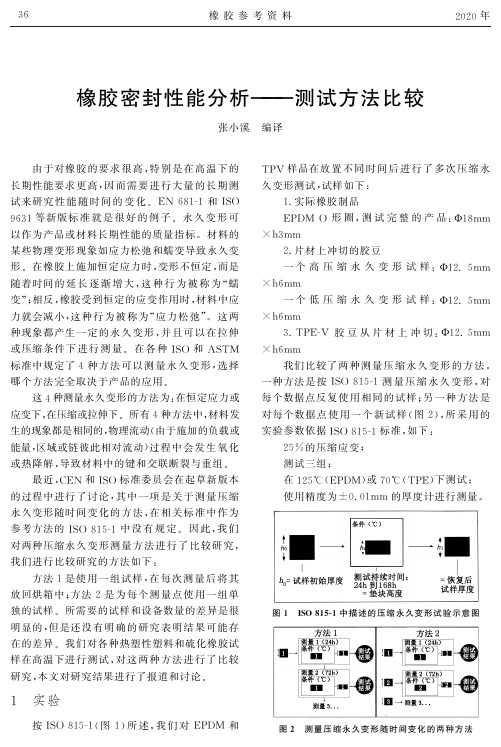
显示了每 3 次测 量 的 平 均 值,误 差 条 显 示 了 最 高
分布的匹配情况.图中绘制了最大值和最小值的
最佳拟合线,以查看测量值的趋势是否存在偏差.
38
橡 胶 参 考 资 料
曲线.
2020 年
最佳拟合线是幂律曲线.
第二项研究用低压缩永久变形和高压缩永久
图 5 示出 了 高 压 缩 永 久 变 形 EPDM 橡 胶 的
对每个数据 点 使 用 一 个 新 试 样 (图 2),所 采 用 的
实验参数依据I
SO815
G
1 标准,如Байду номын сангаас:
25% 的压缩应变;
测试三组;
在 125℃ (
EPDM)或 70℃ (
TPE)下测试;
使用精度为 ±0.
01mm 的厚度计进行测量.
参考方法的 I
SO815
G
1 中 没 有 规 定. 因 此,我 们
分布更真实,因 而 结 果 更 加 精 确.如 果 只 测 试 一
的,因 为 方 法 1 中 每 个 测 量 点 都 有 急 速 冷 却.这
方法 2 的潜在优 点 是 由 于 使 用 了 更 多 试 样,结 果
热条件外,两种方 法 中 影 响 结 果 的 参 数 都 是 相 同
个测试时间,这两种方法之间没有区别,因为测试
36
橡 胶 参 考 资 料
2020 年
橡胶密封性能分析 ——— 测试方法比较
张小溪 编译
由于对橡胶 的 要 求 很 高,特 别 是 在 高 温 下 的
长期性能要求更 高,因 而 需 要 进 行 大 量 的 长 期 测
TPV 样品在放 置 不 同 时 间 后 进 行 了 多 次 压 缩 永
橡胶压缩永久变形标准国标
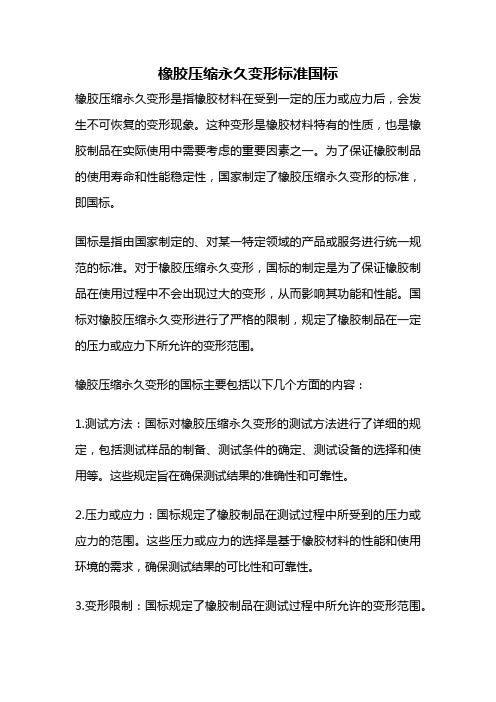
橡胶压缩永久变形标准国标橡胶压缩永久变形是指橡胶材料在受到一定的压力或应力后,会发生不可恢复的变形现象。
这种变形是橡胶材料特有的性质,也是橡胶制品在实际使用中需要考虑的重要因素之一。
为了保证橡胶制品的使用寿命和性能稳定性,国家制定了橡胶压缩永久变形的标准,即国标。
国标是指由国家制定的、对某一特定领域的产品或服务进行统一规范的标准。
对于橡胶压缩永久变形,国标的制定是为了保证橡胶制品在使用过程中不会出现过大的变形,从而影响其功能和性能。
国标对橡胶压缩永久变形进行了严格的限制,规定了橡胶制品在一定的压力或应力下所允许的变形范围。
橡胶压缩永久变形的国标主要包括以下几个方面的内容:1.测试方法:国标对橡胶压缩永久变形的测试方法进行了详细的规定,包括测试样品的制备、测试条件的确定、测试设备的选择和使用等。
这些规定旨在确保测试结果的准确性和可靠性。
2.压力或应力:国标规定了橡胶制品在测试过程中所受到的压力或应力的范围。
这些压力或应力的选择是基于橡胶材料的性能和使用环境的需求,确保测试结果的可比性和可靠性。
3.变形限制:国标规定了橡胶制品在测试过程中所允许的变形范围。
这些变形限制是基于橡胶材料的物理性质和工程实践的需求,确保橡胶制品在使用过程中不会出现过大的变形,从而影响其功能和性能。
4.评定标准:国标规定了橡胶压缩永久变形的评定标准,即根据测试结果对橡胶制品的质量进行评定。
评定标准主要包括合格和不合格两个等级,根据测试结果的符合程度进行判断。
橡胶压缩永久变形的国标的制定对于橡胶制品的生产和应用具有重要的意义。
首先,国标的制定可以确保橡胶制品在使用过程中具有一定的稳定性和可靠性,减少因变形引起的故障和事故。
其次,国标的制定可以促进橡胶制品的技术进步和质量提升,推动橡胶行业的发展和创新。
最后,国标的制定可以提高橡胶制品的质量标准和行业竞争力,提升橡胶制品在市场上的地位和声誉。
橡胶压缩永久变形的国标是为了保证橡胶制品在使用过程中不会出现过大的变形,从而影响其功能和性能。
压缩永久变形中文版

编号:D 395-03橡胶性能的标准试验方法----------压缩永久变形1此项标准在固定编号B 117下发布,紧随编号的数字表示标准采纳的年度,如果是修正,数字表示最后一次修正的年度。
在括号内的数字表示最后一次重申批准的年度。
上标 表示自最后一次修正或重申批准以来的编辑改动。
此项标准已被批准供美国国防部下属机构使用。
1范围1.1本测试方法测试应用中会在气体或液体媒介中承受压力的橡胶。
本测试方法特别适用于在机械固定器件,1.2测试方法可以选择,但是应考虑用于与测试结果关联的实际情况下使用的橡胶的性质。
除非在具体的规范中有其他规定,应使用测试方法B。
1.3测试方法B不适用于硬度大于90IRHD的硫化橡胶。
1.4以国际单位(SI)为单位的数值应被认为是标准。
在括号内的数值起参照作用。
1.5此项标准不包括与其应用有关的所有的安全隐患。
此项标准的使用者有责任在使用前建立合适的安全健康规范以及决定法规限制是否适用2 参考文件2.1 ASTM标准2:D1349 橡胶规范---测试的标准温度D 3182D 3183D 3767D 4483E 145---------------------------------------1此测试方法属于ASTM D 11橡胶委员会的工作范围,是其下属D11.10物理测试子委员会的直接责任。
目前的版本在2008.3.1批准,2008.07出版。
原始的版本在1934年批准。
上一个版本在2003年批准,编号为D395-03.2如需参照ASTM 标准,访问ASTM网站,. 如需要《ASTM标准年鉴》的内容信息,浏览ASTM网站的标准索引页。
3 测试方法概要3.1 用挠力或规定的力压缩试样,并在规定的温度下保持规定的时间。
3.2 在试样在合适的装置内,在规定的条件下经过特定时间的压缩变形后,取出试样,等待30分钟,测量试样的残留变形。
3.3 在测量残留变形后,根据Eq1和Eq2计算压缩永久变形。
橡胶材料的压缩变形率测试方法
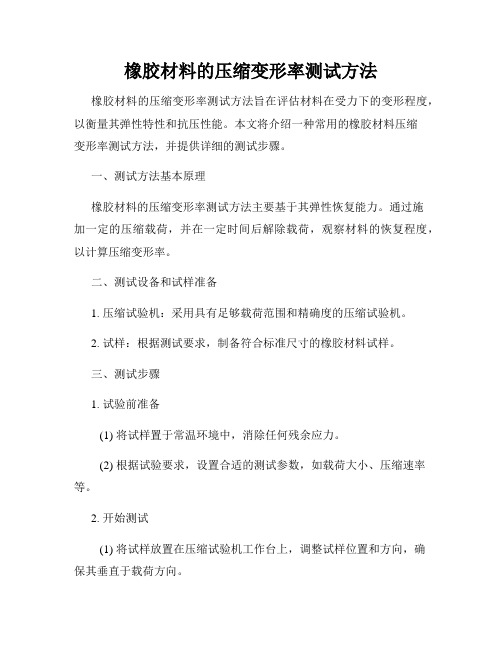
橡胶材料的压缩变形率测试方法橡胶材料的压缩变形率测试方法旨在评估材料在受力下的变形程度,以衡量其弹性特性和抗压性能。
本文将介绍一种常用的橡胶材料压缩变形率测试方法,并提供详细的测试步骤。
一、测试方法基本原理橡胶材料的压缩变形率测试方法主要基于其弹性恢复能力。
通过施加一定的压缩载荷,并在一定时间后解除载荷,观察材料的恢复程度,以计算压缩变形率。
二、测试设备和试样准备1. 压缩试验机:采用具有足够载荷范围和精确度的压缩试验机。
2. 试样:根据测试要求,制备符合标准尺寸的橡胶材料试样。
三、测试步骤1. 试验前准备(1) 将试样置于常温环境中,消除任何残余应力。
(2) 根据试验要求,设置合适的测试参数,如载荷大小、压缩速率等。
2. 开始测试(1) 将试样放置在压缩试验机工作台上,调整试样位置和方向,确保其垂直于载荷方向。
(2) 施加初始压缩载荷,使试样接触承载面。
(3) 在设定的压缩速率下,开始压缩试验,并记录载荷和位移数据。
(4) 持续加载,直到观察到试样的压缩变形达到预定的时间或程度。
3. 解除载荷(1) 解除压缩载荷,使试样恢复到初始状态。
(2) 观察试样的恢复情况,并记录恢复时间和恢复率等数据。
四、数据处理和分析1. 计算压缩变形率压缩变形率可根据以下公式计算:压缩变形率 = (初始高度 - 压缩后高度) / 初始高度 × 100%2. 数据分析和报告对测试数据进行统计和分析,可以绘制压缩变形率-载荷曲线,评估橡胶材料的弹性特性和抗压性能。
将测试结果整理成报告,包括试验条件,数据表格和图表等。
需要注意的是,以上的测试方法仅为一种常用的橡胶材料压缩变形率测试方法,具体的测试方法应根据实际需求和标准要求进行选择。
在进行测试前应熟悉测试设备的操作手册,并遵循实验室安全操作规范。
通过准确的橡胶材料压缩变形率测试方法,可以评估橡胶材料的弹性特性和抗压性能,为材料的选用和工程设计提供科学依据。
2019年硫化橡胶常温、高温下的压缩永久变形试验.doc
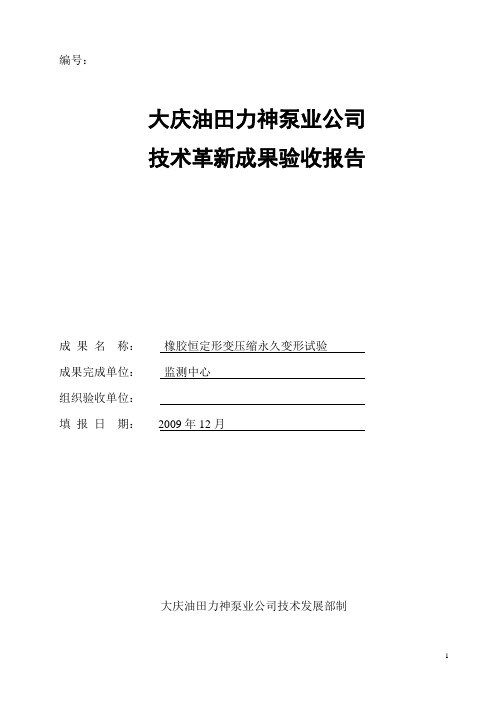
2试验结果
压缩永久变形C(%)按式(1)计算:
C(%)=[(h0-h1)/( (h0-h2)]×100……………(1)
式中:h0——试样原高mm
h1----试样恢复后的高度mm
h2————限制器高度mm
计算结果精确到1%
2..2每个试验结果与中值的差不大于士2%或与算术平均值的差不大于士10%,否则再取三个试样试验,结果是取所有试验数据的中值,并在报告中注明试样的个数。
三、成果应用情况、取得的经济效益和社会效益、详细测算或评价依据、远远景预测
四、主要技术文件提供单位和成果完成协作单位
五、成果应用单位财务部门审核意见(能计算直接经济效益的革新成果)
(财务,公章)
年月日
六、申报单位意见
主管领导(签章):
(单位公章)
年月日
七、(力神泵业公司)专业评审组验收意见
(公章)
年月日
橡胶恒定形变压缩永久变形试验监测中心2009年12概要问题的提出及革新目的原技术状况技术指标等橡胶材料受到外力作用时可以产生两种性质的形变?一种是弹性形变即橡胶受外力作用时发生形变当外力除去后便恢复原状?另一种是塑性形变即橡胶受外力作用时发生的形变外力去除后不能恢复原状而有一部分形变保留环的工作状态基本相同
1.7耐液体试验时,先在试验容器内放入液体,液面为容器高度的二分之一,然后把已装有试样的压缩具放入容器内。试样必须浸没在液体中。试验用的液体不能重复使用。不同配方的试样不可在同一试验容器中进行试验。在液体中试验结束后,将试验容器冷却至接近室温,再把压缩夹具从容器中取出,夹具可用汽油等洗涤,时间不超过30 s,然后按本标准7.5.1进行测量,并在报告中注明试验容器的冷却时间。
压缩永久变形
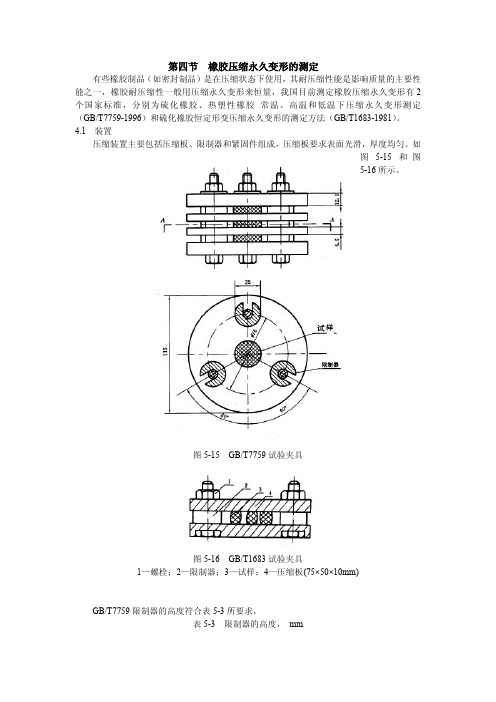
第四节橡胶压缩永久变形的测定有些橡胶制品(如密封制品)是在压缩状态下使用,其耐压缩性能是影响质量的主要性能之一,橡胶耐压缩性一般用压缩永久变形来恒量,我国目前测定橡胶压缩永久变形有2个国家标准,分别为硫化橡胶、热塑性橡胶常温、高温和低温下压缩永久变形测定(GB/T7759-1996)和硫化橡胶恒定形变压缩永久变形的测定方法(GB/T1683-1981)。
4.1装置压缩装置主要包括压缩板、限制器和紧固件组成,压缩板要求表面光滑,厚度均匀。
如图5-15和图5-16所示。
图5-15GB/T7759试验夹具图5-16GB/T1683试验夹具1—螺栓;2—限制器;3—试样;4—压缩板(75×50×10mm)GB/T7759限制器的高度符合表5-3所要求,表5-3限制器的高度,mm试样类型压缩率为25%时压缩率为15%时压缩率为10%时A9.3~9.410.6~10.711.25~11.3B 4.7~4.8 5.3~5.4 5.65~5.7GB/T1683限制器的高度为8±0.02、7±0.02、6±0.02mm。
4.2试样1)试样为圆柱形,GB/T7759试样分为A型和B型两种,A型试样直径为29±0.5mm,高为12.5±0.5mm;B型试样直径为13±0.5mm,高为6.3±0.3mm。
最好用A型试样,B 型试样适用从成品上裁取GB/T1683。
试样直径为10±0.2mm,高为10±0.2mm。
2)试样最好用模具硫化,也可以从胶片或成品上裁取。
3)试样不得有气泡、杂质等。
4)试样的数量为3个。
5)从硫化到试验之间时间不少于16h不超过4周,成品取样为3个月。
制好的试样试验前要在试验标准温度下调节不少于3h。
4.3试验条件⑴试验时间可选用24h、、48h、72h、96h、120h、144h、168h和168h的倍数。
ASDM-低温下的压缩永久变形试验[1]
![ASDM-低温下的压缩永久变形试验[1]](https://img.taocdn.com/s3/m/fca6f7d83186bceb19e8bb77.png)
标准试验方法——橡胶低温下永久变形性能试验1. 范围这个试验方法包括了硫化橡胶性能的评估。
在室温下压缩橡胶,然后在低温下(空气或者二氧化碳)放置,在低温下将其从压接装置中取出,观察其形变回复情况。
1.2 用国际单位制来记录的值即标准值,而括号中的数据只是作为参考使用。
1.3 这个标准没有任何安全隐患。
此测试方法的使用者应注意安全。
2.参考文件2.1 ASTM标准:D375 橡胶性能试验方法——压缩永久变形D832 橡胶性能测试方法——低温测试D3767 橡胶实务——尺寸测量D4483 橡胶和炭黑工业试验方法标准之测试精确度的决定3. 试验方法概述3.1 在室温下,试样将被压缩至它原厚度的25%,然后在设定的低温下放置一段特定时间。
3.2 仍在试验温度下,将此试样恢复(解压)3.3 将试样从压缩仪器中取出后,在10秒和30分钟两个时间点测量其剩余压缩量。
3.4 根据9.1中的公式计算压缩永久形变。
4. 重要性和应用橡胶产品可能会被暴露在各种极端温度下,例如是飞行器用的液压密封件制品,潜艇舱密封垫制品,液压制动器皮碗圈。
此测试方法可以给出一个极限范围,一个在持续暴露在低温下的压缩力得到释放时,常温下的压缩恢复程度会受到抑制的极限范围;5. 压缩永久形变对于这个试验来说,硫化橡胶的永久形变就是指试样厚度减少的百分比,是不可恢复的。
而常见的高温下的形变,在将试样放置常温环境中会恢复其原有厚度。
6. 仪器6.1 压缩永久形变夹具,配有合适的钢制间隔条,见D395中B方法。
6.2 测微仪,见D37676.3 低温试验箱,用干冰,液态二氧化碳,液氮,或者适宜物理冷冻的从顶上打开的,温度可以控制在61°C (1.8°F)之内(见D832)。
试验箱应该配备一把老虎钳,'C'形螺丝钳或者其他可以固定住夹具的工具。
7. 试样标准试样应该是一个圆柱形薄片,直径在29±0.5mm(1.14±0.02),厚度在12.5±0.5mm (0.4±0.02),见试验方法D395。
橡胶和热塑性弹性体压缩永久变形阐述和解决方案
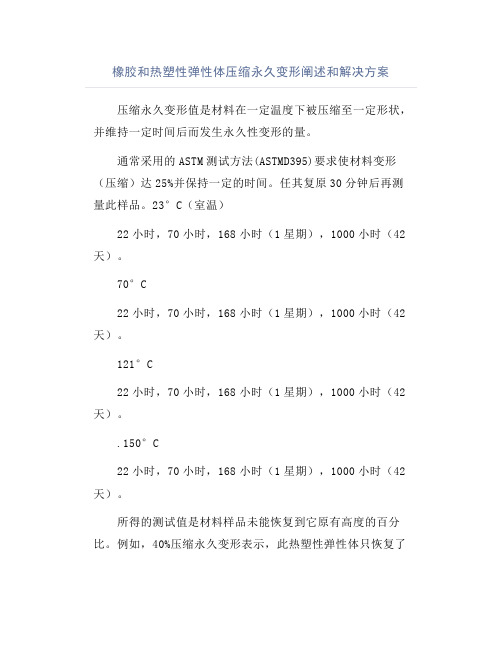
橡胶和热塑性弹性体压缩永久变形阐述和解决方案压缩永久变形值是材料在一定温度下被压缩至一定形状,并维持一定时间后而发生永久性变形的量。
通常采用的ASTM测试方法(ASTMD395)要求使材料变形(压缩)达25%并保持一定的时间。
任其复原30分钟后再测量此样品。
23°C(室温)22小时,70小时,168小时(1星期),1000小时(42天)。
70°C22小时,70小时,168小时(1星期),1000小时(42天)。
121°C22小时,70小时,168小时(1星期),1000小时(42天)。
.150°C22小时,70小时,168小时(1星期),1000小时(42天)。
所得的测试值是材料样品未能恢复到它原有高度的百分比。
例如,40%压缩永久变形表示,此热塑性弹性体只恢复了被压缩厚度的60%。
100%压缩永久变形则表示此热塑性弹性体无丝毫恢复,也就是说,它保持了被压缩的状态。
往往压缩永久变形易与蠕变相混淆。
然而,压缩永久变形是在某一恒定的应变条件下所发生变形的量,而蠕变则是在某一恒定应力条件下所发生变形的量。
变形是橡胶制品的重要性能指标之一。
硫化橡胶压缩永久变形的大小,涉及到硫化橡胶的弹性与恢复。
有些人往往简单地认为橡胶的弹性好,其恢复就快,永久变形就小。
这种理解是不够的,弹性与恢复是相互关联的两种性质。
但有时候,橡胶的本质没有发生根本的变化,永久变形的大小主要是受橡胶恢复能力的变化所支配。
影响恢复能力的因素有分子之问的作用力(粘性)、网络结构的变化或破坏、分子问的位移等。
当橡胶的变形是由于分子链的伸张引起的,它的恢复(或永久变形的大小)主要由橡胶的弹性所决定:如果橡胶的变形还伴有网络的破坏和分子链的相对流动,这部分可以说是不可恢复的,它是与弹性无关的。
所以,凡是影响橡胶弹性与恢复的因素,都是影响硫化橡胶压缩永久变形的因素。
有几个概念,如弹性、打击弹性(回弹性)、弹性与模量、压缩永久变形、扯断永久变形等,它们之间的关系,不易表述清楚,现将个人的理解提出与大家讨论。
压缩永久变形测试操作规范

文件编号 文件名称 核 准
压缩永久变形测试操作规范
审 核
版 页 制
本 次 定
1.1 第1页/共1页 品保课
1.目的:规范橡胶压缩永久变形测试方法,保证硫化橡胶永久压缩变形测试的准确性。 2.范围:适用于硫化橡胶压缩永久变形的测定。 3.使用仪器:橡胶压缩永久变形仪装置。 4.测试方法: 4.1 试样准备: 4.1.1 在测试前将试样放置在温度为25 ±2℃的环境中至少1小时。 4.1.2 试验前检查试样,如果试样表面有杂物,须用纱布沾酒精擦净。 4.1.3 测量试样的原始厚度并记录,取精度为0.01mm,同种材质试样至少2个以上。 4.1.4 根据试样厚度和压缩量要求计算垫片厚度,通常压缩量为25%。 4.2 试验前准备: 4.2.1 将试样放入压力装置的压力片间,试样两边和中间都应有垫片,垫片与试样间应有足 够的距离。 4.2.2 试样、垫片和压力片放好之后,锁紧固定螺丝,使压力片和垫片接触。 4.2.3 当放入压缩永久变形仪装置时,试样的温度应为室温。在组装完成后1小时内将装置放 入已设置好的恒温烘箱。 4.2.4 根据客户或工程部指定要求选择温度和时长,常用的测试条件为NBR材质:100℃*22h, 硅胶材质:175℃*22h,其他材质:70℃*22h,在对比测试中应使用相同的温度和加 热时间。 4.2.5 测试结束后,从烘箱中取出装置,马上取出试样在室温下冷却30分钟后,测试最终厚度。 4.2.6 B042客户的测试要求从烘箱取出装置后,需在室温下冷却120分钟,再取出试样在室温下 冷却30分钟后,测试最终厚度。 4.3 实验结果计算: 试样原厚度-试验后试样厚度 试样厚度-垫片厚度 4.4 求出几个试样的平均值,将结果记入<压缩歪测试报告>中。 4.5 保持试验装置干净,定时上防锈油。
ASTM_D395_2003压缩永久变形中文版

编号:D 395-03橡胶性能的标准试验方法----------压缩永久变形1此项标准在固定编号B 117下发布,紧随编号的数字表示标准采纳的年度,如果是修正,数字表示最后一次修正的年度。
在括号的数字表示最后一次重申批准的年度。
上标 表示自最后一次修正或重申批准以来的编辑改动。
此项标准已被批准供美国国防部下属机构使用。
1围1.1本测试方法测试应用中会在气体或液体媒介中承受压力的橡胶。
本测试方法特别适用于在机械固定器件,减震器,封条中使用的橡胶。
本测试方法包含以下两种方法:1.2测试方法可以选择,但是应考虑用于与测试结果关联的实际情况下使用的橡胶的性质。
除非在具体的规中有其他规定,应使用测试方法B。
1.3测试方法B不适用于硬度大于90IRHD的硫化橡胶。
1.4以国际单位(SI)为单位的数值应被认为是标准。
在括号的数值起参照作用。
1.5此项标准不包括与其应用有关的所有的安全隐患。
此项标准的使用者有责任在使用前建立合适的安全健康规以及决定法规限制是否适用2 参考文件2.1 ASTM标准2:D1349 橡胶规---测试的标准温度D 3182 混合标准化合物及制备标准硫化橡胶薄片用橡胶材料、设备及工序的标准实施规程D 3183 橡胶实施规---从橡胶制品中制备试验目的用试片D 3767 橡胶的标准规程----尺寸测量D 4483 评定橡胶和炭黑制造工业试验方法标准的精度的实施规程E 145 重力对流式和强制通风式烘炉的规---------------------------------------1此测试方法属于ASTM D 11橡胶委员会的工作围,是其下属D11.10物理测试子委员会的直接责任。
目前的版本在2008.3.1批准,2008.07出版。
原始的版本在1934年批准。
上一个版本在2003年批准,编号为D395-03.2如需参照ASTM 标准,访问,或联系ASTM客户服务. 如需要《ASTM标准年鉴》的容信息,浏览ASTM的标准索引页。
橡胶压缩永久变形率测定常用标准分析与解读
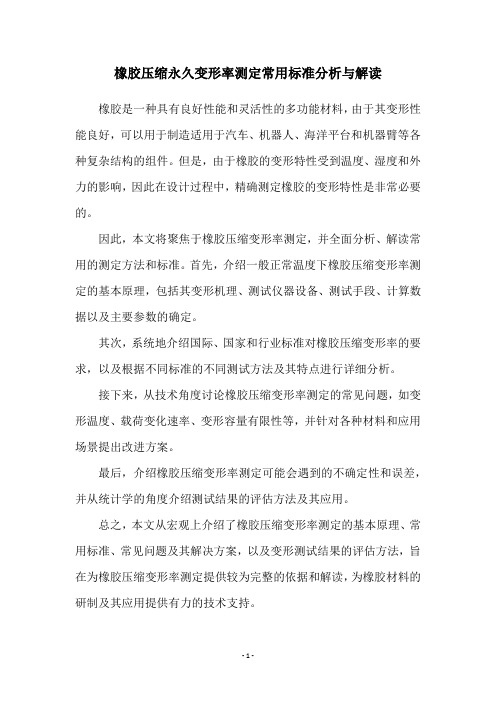
橡胶压缩永久变形率测定常用标准分析与解读橡胶是一种具有良好性能和灵活性的多功能材料,由于其变形性能良好,可以用于制造适用于汽车、机器人、海洋平台和机器臂等各种复杂结构的组件。
但是,由于橡胶的变形特性受到温度、湿度和外力的影响,因此在设计过程中,精确测定橡胶的变形特性是非常必要的。
因此,本文将聚焦于橡胶压缩变形率测定,并全面分析、解读常用的测定方法和标准。
首先,介绍一般正常温度下橡胶压缩变形率测定的基本原理,包括其变形机理、测试仪器设备、测试手段、计算数据以及主要参数的确定。
其次,系统地介绍国际、国家和行业标准对橡胶压缩变形率的要求,以及根据不同标准的不同测试方法及其特点进行详细分析。
接下来,从技术角度讨论橡胶压缩变形率测定的常见问题,如变形温度、载荷变化速率、变形容量有限性等,并针对各种材料和应用场景提出改进方案。
最后,介绍橡胶压缩变形率测定可能会遇到的不确定性和误差,并从统计学的角度介绍测试结果的评估方法及其应用。
总之,本文从宏观上介绍了橡胶压缩变形率测定的基本原理、常用标准、常见问题及其解决方案,以及变形测试结果的评估方法,旨在为橡胶压缩变形率测定提供较为完整的依据和解读,为橡胶材料的研制及其应用提供有力的技术支持。
- 1 -。
压缩永久变形试验标准分析解读
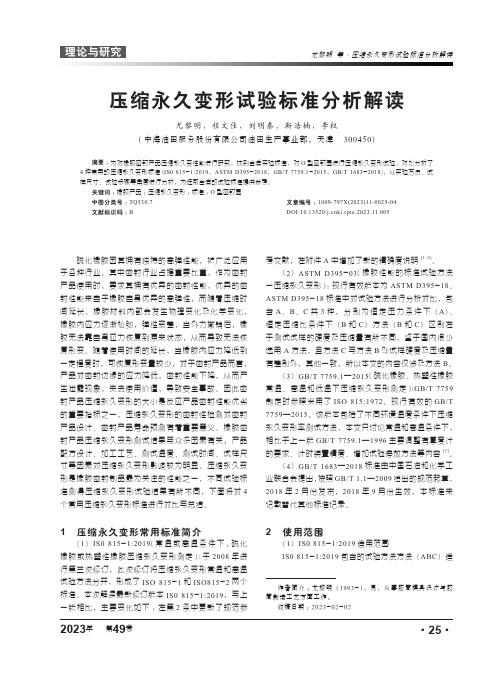
作者简介:尤黎明(1993-),男,从事胶筒模具设计与胶筒制造工艺方面工作。
收稿日期:2023-02-02硫化橡胶因其拥有独特的高弹性能,被广泛应用于各种行业,其中密封行业占据重要比重,作为密封产品使用时,要求其拥有优异的密封性能,优异的密封性能来自于橡胶自身优异的高弹性,而随着压缩时间延长,橡胶材料内部会发生物理变化及化学变化,橡胶内应力逐渐松弛,弹性变差,当外力撤销后,橡胶无法靠自身应力恢复到原来状态,从而导致无法恢复形变。
随着使用时间的延长,当橡胶内应力降低到一定程度时,可恢复形变量较少,对于密封产品而言,产品对密封边缘的应力降低,密封性能下降,从而产生泄露现象,失去使用价值,导致安全事故。
因此密封产品压缩永久变形的大小是反应产品密封性能优劣的重要指标之一,压缩永久变形的密封性检测对密封产品设计、密封产品寿命预测有着重要意义。
橡胶密封产品压缩永久变形测试结果与众多因素有关,产品配方设计、加工工艺、测试温度、测试时间、试样尺寸等因素对压缩永久变形影响较为明显。
压缩永久变形是橡胶密封制品最为关注的性能之一,不同试验标准测得压缩永久变形试验结果有所不同,下面将对4个常用压缩永久变形标准进行对比与总结。
1 压缩永久变形常用标准简介(1)IS0 815-1:2019(常温或高温条件下,硫化橡胶或热塑性橡胶压缩永久变形测定):于2008年进行第三次修订,此次修订将压缩永久变形常温和高温试验方法分开,形成了ISO 815-1和ISO815-2两个标准。
本次解读最新修订版本IS0 815-1:2019,与上一版相比,主要变化如下:在第2条中更新了规范参压缩永久变形试验标准分析解读尤黎明,程文佳,刘明泰,靳浩楠,李权(中海油田服务股份有限公司油田生产事业部,天津 300450)摘要:为对橡胶密封产品压缩永久变性能进行研究,找到合适实验标准,对O 型密封圈进行压缩永久变形试验,对比分析了4种常用的压缩永久变形标准(IS0 815-1:2019,ASTM D395-2018,GB/T 7759.1-2015,GB/T 1683-2018),从实验方法、试样尺寸、试验步骤等角度进行分析,为选取合适的试验标准提供参考。
橡胶低温压缩永久变形测试方法

橡胶低温压缩永久变形测试方法1. 概述橡胶是一种常见的材料,具有良好的弹性和可塑性,在工业生产和日常生活中都有广泛的应用。
然而,橡胶在低温环境下容易发生压缩永久变形,这对其使用性能提出了挑战。
对橡胶材料进行低温压缩永久变形测试具有重要的意义。
2. 低温压缩永久变形测试方法低温压缩永久变形测试方法主要包括以下几个步骤:2.1 试样制备:从橡胶制品中取得代表性试样,通常为长方体或圆柱形状。
根据国际标准或企业内部规范,对试样进行尺寸和形状的测量和加工,确保试样符合测试要求。
2.2 低温条件设定:将试样放置在低温环境中,通常为-40°C或更低的温度,以模拟橡胶在特殊低温环境下的应用情况。
2.3 压缩加载:对试样施加一定的压缩载荷,在规定的时间内进行加载。
可以通过机械压力机或其他专用设备来完成这一步骤。
2.4 保持载荷:在加载后的一定时间内保持试样处于压缩状态,通常为24小时或更长时间。
2.5 卸载和恢复:卸载试样载荷,并观察试样在恢复一定时间后的变形情况。
记录试样的恢复率和永久变形率,作为评估指标。
3. 测试结果的分析和应用低温压缩永久变形测试的主要目的是评估橡胶材料在低温环境下的变形特性,以指导材料的选择和工程应用。
通过测试结果的分析,可以评估不同橡胶材料在低温下的性能差异,为工程设计和产品研发提供参考依据。
还可以通过优化橡胶配方和工艺,改善材料的低温性能,提高产品的可靠性和耐用性。
4. 个人观点和总结低温压缩永久变形测试对于橡胶材料的研究与开发具有重要的意义,尤其是在航空航天、汽车和电子产品等领域。
通过科学的测试方法和数据分析,可以更好地理解橡胶材料在低温环境下的性能特点,为产品的设计和制造提供更可靠的支持。
在未来的工作中,我将继续关注这一领域的发展,不断提升自己的专业能力,为橡胶材料的研究和应用贡献自己的力量。
通过以上步骤,我希望我可以帮你撰写一篇高质量、深度和广度兼具的中文文章,对于橡胶低温压缩永久变形测试方法有更全面、深刻和灵活的理解。
D395 压缩永久变形测试 中文版

名称:D 395 - 01橡胶性能的标准测试方法—压缩永久变形此项标准在固定编号D395下发行,紧随编号的数字表示采纳的年度,如果是修正,数字表示最后一次修正年度,在括号内数字表示最后一次重申批准的年度,上标E表示自最后一次修正或重申批准以来的编辑改动此项标准已被批准供美国国防部下属机构使用1. 范围1.1本测试方法测试使用中会在气体或液体媒介中承受压力的橡胶.本测试方法特别适用于在机械固定器件,减震器,封条中使用的橡胶.本测试方法包括以下两种方法规范中有其他规定,应使用测试方法B1.3测试方法B不适用于硬度大于90IRHD的硫化橡胶1.4以国际单位(SI)为单位的数值应被认为是标准1.5此项标准不包括与其应用有关的所有的安全隐患,此项标准的使用者有责任在使用前建立合适的安全健康规范以及法定法规限制是否适用2. 参考文件2.1ASTM标准:D 1349 橡胶规范—测试的标准温度D 3182 混合标准化合物和制备标准硫化橡胶薄片用橡胶材料,设备及工序的标准实施规程D 3183 橡胶实施规范—用橡胶制品制备测试样片D 3767 橡胶的标准规程—尺寸测量D 4483 评定橡胶和炭黑制造工业试验方法标准精度的实施规程E 145 重力对流式和强制通风式烘箱的规范---------------------------------------此测试方法属于ASTM D11橡胶委员会的工作范围,是其下属D11 .10物理测试委员会的直接责任目前的版本在2001.5.10批准 2001.7出版,原始出版是D395-34,最后编辑版本是D395-34ASTM标准年度书刊 Vol 09.013. 试验方法概要3.1在挠力或规定的力下压缩试样,并在规定的温度下保持规定的时间3.2试样在合适的装置内,在规定的条件下经过特定时间的压缩变形后,取出试样,等30分钟,测量试样的残余变形3.3测量残余变形之后,根据Eq1和Eq2计算压缩永久变形4. 意义和用途4.1压缩永久变形测试用于测量在长时间受压后,橡胶化合物保持弹性的能力。
橡胶材料的压缩变形测试方法

橡胶材料的压缩变形测试方法橡胶材料被广泛应用于各种领域,如汽车工业、建筑工程、医疗器械等。
了解橡胶材料的力学性能是保证其正确使用的重要前提。
其中,压缩变形是橡胶材料力学性能中的一个重要指标。
本文将介绍橡胶材料的压缩变形测试方法,以帮助读者更好地理解橡胶材料的性能。
一、压缩变形测试的目的和意义压缩变形测试主要用于评估橡胶材料在受力情况下的变形性能。
通过该测试,可以了解橡胶材料在压缩载荷下的变形程度,为相关工程设计和材料选择提供依据。
同时,压缩变形测试还可以评估橡胶材料的弹性恢复能力,即材料在去除压力后恢复到原始状态的能力。
二、压缩变形测试的方法1. 样品准备在进行压缩变形测试前,首先需要准备好橡胶样品。
通常采用圆盘状或方块状的样品,其尺寸应符合相关标准或设计要求。
样品制备时应注意避免损坏或污染。
2. 仪器设备常用的压缩变形测试设备有压力机和万能材料测试机。
其中,万能材料测试机具有更广泛的适用范围,可以进行多种力学性能测试。
3. 测试过程(1)将样品精确放置在测试设备的压缩载荷平台上。
(2)设置测试参数,如压力大小、速度等。
这些参数应根据实际需求和相关标准进行设置。
(3)施加压力,使样品发生压缩变形。
此时,测试设备会记录压力和变形数据。
(4)持续施加压力一定时间后,停止施力,观察样品的弹性恢复情况。
4. 数据分析和结果通过测试设备提供的数据,可以进行数据分析和结果计算。
常见的结果指标包括压缩变形率、压缩模量等。
这些指标可以用于评估材料的变形性能,并与相关标准或设计要求进行对比。
三、注意事项在进行压缩变形测试时,需要注意以下几个方面:1. 样品准备:样品的尺寸和几何形状应符合相关标准或设计要求。
样品的制备过程应避免对材料性能产生不必要的影响。
2. 测试环境:测试应在适宜的温度和湿度条件下进行,以保证测试结果的准确性。
3. 测试参数:测试参数的设置应根据实际需求和相关标准进行选择,以保证测试的可靠性和可重复性。
ASTM D395-2003压缩永久变形中文版
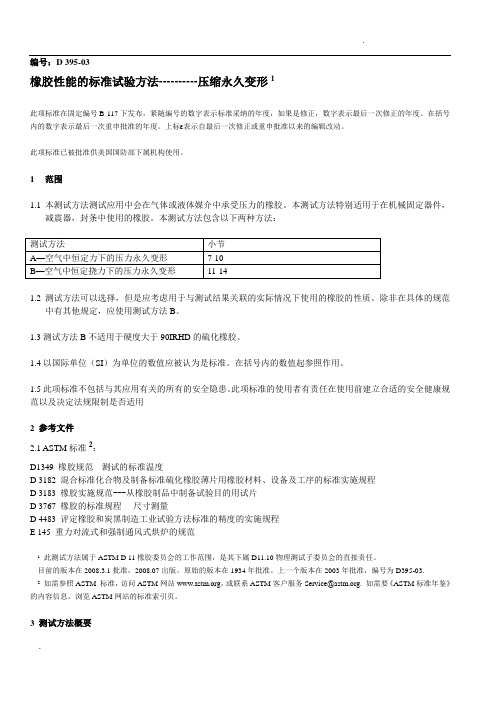
编号:D 395-03橡胶性能的标准试验方法----------压缩永久变形1此项标准在固定编号B 117下发布,紧随编号的数字表示标准采纳的年度,如果是修正,数字表示最后一次修正的年度。
在括号内的数字表示最后一次重申批准的年度。
上标 表示自最后一次修正或重申批准以来的编辑改动。
此项标准已被批准供美国国防部下属机构使用。
1范围1.1本测试方法测试应用中会在气体或液体媒介中承受压力的橡胶。
本测试方法特别适用于在机械固定器件,减震器,封条中使用的橡胶。
本测试方法包含以下两种方法:1.2测试方法可以选择,但是应考虑用于与测试结果关联的实际情况下使用的橡胶的性质。
除非在具体的规范中有其他规定,应使用测试方法B。
1.3测试方法B不适用于硬度大于90IRHD的硫化橡胶。
1.4以国际单位(SI)为单位的数值应被认为是标准。
在括号内的数值起参照作用。
1.5此项标准不包括与其应用有关的所有的安全隐患。
此项标准的使用者有责任在使用前建立合适的安全健康规范以及决定法规限制是否适用2 参考文件2.1 ASTM标准2:D1349 橡胶规范---测试的标准温度D 3182 混合标准化合物及制备标准硫化橡胶薄片用橡胶材料、设备及工序的标准实施规程D 3183 橡胶实施规范---从橡胶制品中制备试验目的用试片D 3767 橡胶的标准规程----尺寸测量D 4483 评定橡胶和炭黑制造工业试验方法标准的精度的实施规程E 145 重力对流式和强制通风式烘炉的规范---------------------------------------1此测试方法属于ASTM D 11橡胶委员会的工作范围,是其下属D11.10物理测试子委员会的直接责任。
目前的版本在2008.3.1批准,2008.07出版。
原始的版本在1934年批准。
上一个版本在2003年批准,编号为D395-03.2如需参照ASTM 标准,访问ASTM网站,或联系ASTM客户服务Service@. 如需要《ASTM标准年鉴》的内容信息,浏览ASTM网站的标准索引页。
橡胶压缩永久变形测试标准
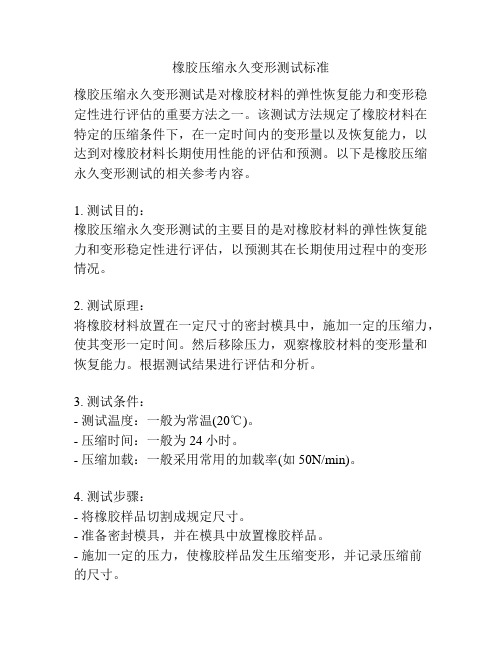
橡胶压缩永久变形测试标准橡胶压缩永久变形测试是对橡胶材料的弹性恢复能力和变形稳定性进行评估的重要方法之一。
该测试方法规定了橡胶材料在特定的压缩条件下,在一定时间内的变形量以及恢复能力,以达到对橡胶材料长期使用性能的评估和预测。
以下是橡胶压缩永久变形测试的相关参考内容。
1. 测试目的:橡胶压缩永久变形测试的主要目的是对橡胶材料的弹性恢复能力和变形稳定性进行评估,以预测其在长期使用过程中的变形情况。
2. 测试原理:将橡胶材料放置在一定尺寸的密封模具中,施加一定的压缩力,使其变形一定时间。
然后移除压力,观察橡胶材料的变形量和恢复能力。
根据测试结果进行评估和分析。
3. 测试条件:- 测试温度:一般为常温(20℃)。
- 压缩时间:一般为24小时。
- 压缩加载:一般采用常用的加载率(如50N/min)。
4. 测试步骤:- 将橡胶样品切割成规定尺寸。
- 准备密封模具,并在模具中放置橡胶样品。
- 施加一定的压力,使橡胶样品发生压缩变形,并记录压缩前的尺寸。
- 保持一定的压缩时间后,移除压力。
- 观察橡胶样品的恢复情况,并记录变形量。
- 根据测试结果进行评估和分析。
5. 测试结果评估:- 变形量:根据实际测量的变形量,评估橡胶样品的压缩永久变形程度。
通常以变形量的百分比表示。
- 恢复能力:根据橡胶样品的恢复能力,评估橡胶样品的弹性恢复性能。
通常以恢复率或恢复时间表示。
6. 结果报告:测试结果应当清晰准确地记录在测试报告中,包括橡胶样品的描述、测试条件、变形量、恢复能力等信息。
同时,应当进行数据分析和结论,提供对橡胶材料性能的评估和预测。
总结:橡胶压缩永久变形测试是对橡胶材料的弹性恢复能力和变形稳定性进行评估的重要方法。
测试标准涉及测试目的、测试原理、测试条件、测试步骤、测试结果评估和结果报告等内容。
通过该测试方法,可以预测橡胶材料长期使用性能,为橡胶制品的设计和选材提供科学依据。
压缩永久变形[1]
![压缩永久变形[1]](https://img.taocdn.com/s3/m/cf62107002768e9951e73877.png)
第四节橡胶压缩永久变形的测定有些橡胶制品(如密封制品)是在压缩状态下使用,其耐压缩性能是影响质量的主要性能之一,橡胶耐压缩性一般用压缩永久变形来恒量,我国目前测定橡胶压缩永久变形有2个国家标准,分别为硫化橡胶、热塑性橡胶常温、高温和低温下压缩永久变形测定(GB/T7759-1996)和硫化橡胶恒定形变压缩永久变形的测定方法(GB/T1683-1981)。
4.1 装置压缩装置主要包括压缩板、限制器和紧固件组成,压缩板要求表面光滑,厚度均匀。
如图5-15和图5-16所示。
图5-15 GB/T7759试验夹具图5-16 GB/T1683试验夹具1—螺栓;2—限制器;3—试样;4—压缩板(75×50×10mm)GB/T7759限制器的高度符合表5-3所要求,表5-3 限制器的高度,mm试样类型压缩率为25%时压缩率为15%时压缩率为10%时A 9.3~9.4 10.6~10.7 11.25~11.3B 4.7~4.8 5.3~5.4 5.65~5.7GB/T1683限制器的高度为8±0.02、7±0.02、6±0.02mm。
4.2 试样1)试样为圆柱形,GB/T7759试样分为A型和B型两种,A型试样直径为29±0.5mm,高为12.5±0.5mm;B型试样直径为13±0.5mm,高为6.3±0.3mm。
最好用A型试样,B 型试样适用从成品上裁取GB/T1683。
试样直径为10±0.2mm,高为10±0.2mm。
2)试样最好用模具硫化,也可以从胶片或成品上裁取。
3)试样不得有气泡、杂质等。
4)试样的数量为3个。
5)从硫化到试验之间时间不少于16 h不超过4周,成品取样为3个月。
制好的试样试验前要在试验标准温度下调节不少于3h。
4.3 试验条件⑴试验时间可选用24 h、、48 h、72 h、96 h、120 h、144 h、168 h和168 h的倍数。
- 1、下载文档前请自行甄别文档内容的完整性,平台不提供额外的编辑、内容补充、找答案等附加服务。
- 2、"仅部分预览"的文档,不可在线预览部分如存在完整性等问题,可反馈申请退款(可完整预览的文档不适用该条件!)。
- 3、如文档侵犯您的权益,请联系客服反馈,我们会尽快为您处理(人工客服工作时间:9:00-18:30)。
创作编号:
GB8878185555334563BT9125XW
创作者:凤呜大王*
橡胶制品压缩永久变形测试
1.定义和方法
橡胶压缩永久变形,是指压缩橡胶试样在完全去掉引起其压缩形变的力之后所剩余的变形。
其用于判定橡胶材料的交织密度,受力状况下的物性。
试验方法通常有三种:
1)方法A:在恒定压力作用下,空气中作压缩试验
2)方法B:在空气中恒定形变压缩试验
3)方法C:在空气(气体)或液体中,恒定形变压缩试验
在方法的选择中一般选用B,但是方法B、C不适合于IRHD>90℃的硬度胶料中。
以上三种方法可以做常温、高温、低温或溶液中的形变测试。
2.简单的测试步骤如下:
1)按照要求制作压缩永久变形的试块或直接用产品或部分产品(如O-ring,Washer,Disc等);
2)用夹具将试块固定并压缩到一定的压缩量(压缩率),在一定试验条件(通常是一定温度和时间,有时会浸泡在溶液中测试)后取出;
3)在2的操作过程中记录相应数据,同时记录取出的产品在室温下放置30分钟后的数值(有些客户要求不松开夹具放置30分钟,后松开30分钟后测量);
4)按照压缩永久变形的公式计算在要求温度时间和变形量的前提下的压缩永久变形。
3.压缩永久变形CS的计算方法:
CS=(h0-h2)/(h0-h1)
h0:压缩前试样的高度,mm
h1:限制器的高度,mm
h2:试样恢复后的高度,mm
4.结果判定:
在压缩永久变形中,对于所测的每一个样品,都要在标准内,否则视为不合格。
在每一个数据都在标准内时,一般测三个样品的试验,最后数值以平均值记录,如果五个样品,一般去掉最大和最小的数值,其余求平均值一般测试需要4-5样品。
5. 压缩永久变形的影响因素:
1)橡胶配方,此决定压缩永久变形好坏的最大关键;如过氧化物硫化的EPDM压缩永久变形比硫磺硫化的小非常多,而且可以通过更高温度的测试;
2)加硫程度,取决于橡胶成型三大因素-温度,时间,压力。
正常的橡胶随加硫程度的增加而压缩永久变形变小,到最低值后就开始变大,这时意味着橡胶产品开始过硫化了;特别需要说明的是硫磺硫化的NBR,EPDM等,一次加硫和二次加硫均对此影响非常大(尤其是温度);而过氧化物硫化的NBR,EPDM,一次成型的温度尤其重要,建议在180摄氏度以上,如果一次加硫不足,二次加硫的补足有限;
3)测试样品的形状和测试夹具,量具和试验设备的精密性均会影响最后的结果,但不是橡胶压缩永久变形的真因。
6. 补充说明:
ASTM D1414 O-RING测量方法,方法于D395大致相同,但垫片和制取样品方法不同:
⑴间隔板是金属片,有可调节0.025MM公差,以组合不同厚度的O-RING产品,压缩率通常为25﹪(特殊压缩率由客户指定);
⑵制品制取:从O-RING上切取,通常对于内径大于17MM O-RING切取52MM部分作样品,对于内径小于17MM时,切除3MM余下部分作样品。
一般说来,以整个O-RING作压缩永久变形是无效的。
至少要从同一批次中取3个样品,最好为5个。
结果计算同上。
创作编号:
GB8878185555334563BT9125XW
创作者:凤呜大王*。
